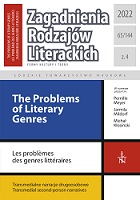„Ty jesteś tym”. Rola narracji drugoosobowej w powieści Pawła Palińskiego Polaroidy z zagłady
„You are that”. The Role of Second-Person Narrative in Pawel Palinski’s Novel Polaroids from Doom
Author(s): Marta Błaszkowska-NawrockaSubject(s): Polish Literature, Theory of Literature, Sociology of Literature
Published by: Łódzkie Towarzystwo Naukowe
Keywords: Paweł Paliński; Polaroidy z zagłady (Polaroids from Doom); second-person narrative; polish literature;
Summary/Abstract: This article is an analysis of Paweł Paliński’s novel Polaroidy z zagłady (Polaroids from Doom) in the context of its use of second-person narrative. Paliński’s work describes a post-apocalyptic world where people have turned into mindless, lethargic creatures. This is the reality in which the sole survivor of the apocalypse and the main heroine of the story, Teresa Szulc, struggles to persevere. The novel approaches the topics of returning to a normal life after a crisis and human solitude in a particularly interesting way. The main lens through which the novel is examined is through Jacques Lacan’s psychoanalytical theory, whose application enables this interpretation of Polaroidy… as a story about the disintegration of the symbolic order. Themes that are crucial to understanding this aspect of the narrative include: the permanent absence of the other person, the lack of an external perspective on oneself, and the nonexistence of potential spectators. Teresa Szulc feels hauntingly lonely, because no one can see her — and those are the circumstances in which she has to ask herself who she actually is. Because of this, the use of the second-person narrative seems especially thought-provoking. The heroine is indeed alone in this world, and yet someone still speaks to her; the article is an attempt to answer not only the question of the speaker’s identity, but — even more importantly — of the role of such literary strategy and the way in which it affects both the main character and the reader.
Journal: Zagadnienia Rodzajów Literackich
- Issue Year: 65/2022
- Issue No: 4
- Page Range: 113-124
- Page Count: 12
- Language: Polish

